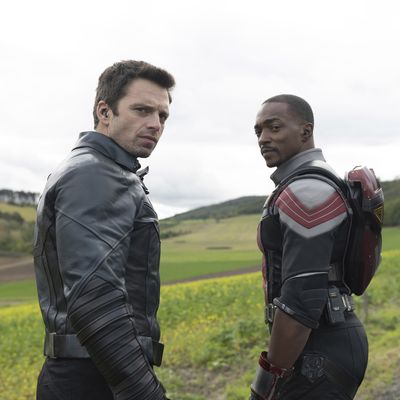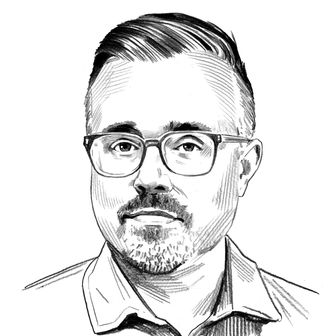
The Falcon and the Winter Soldier gets its title characters together this week for some action and some scenes that basically feel like couples therapy. It feels like much of the success of this show is going to hinge on the buddy-action chemistry between Anthony Mackie and Sebastian Stan, and the good news is that it’s pretty strong so far, with Stan’s world-weary cynicism balanced well by Mackie’s driven heroism. They make a good team, and it’s important that they feel equal so far, with neither hero stealing too much focus as a lead. They are sidekicks no more. Just don’t tell that to Captain America.
Yes, Captain America is back! Sorta. “The Star-Spangled Man” is really a very transitional episode in the sense that it introduces us to a few major players of this short series other than the ones in the title, like Lemar Hoskins, Isaiah Bradley, and Karli Morgenthau. The most important of this group is a man named John Walker (Wyatt Russell), who has been chosen to carry the shield of Captain America. While the world seems welcoming to a new hero stepping into the shoes of Steve Rogers, Cap’s buddies aren’t taking the news as well, skeptical of whether this square-jawed All-American really has what it takes to be a true hero.
Some of the most interesting thematic elements of The Falcon and the Winter Soldier are starting to emerge in this episode, particularly the concept of heroism and how it’s perceived by the people who need heroes to save them. The world needs costumed superpeople to fight the “androids, aliens, and wizards” that threaten it, but Sam Wilson wasn’t ready to be the No. 1 hero. His reasons for turning down Cap’s shield last week were a little vague — he simply said that it belonged to someone else — but the writers start to dig into some potentially interesting ideas in this episode with the introduction of Isaiah Bradley (Carl Lumbly) this week, a “Black Captain America” that Sam and Steve never even knew about, and who was disowned and abused by his own country. Even in the world of Marvel, Black heroes are treated differently.
This emerging theme also feels reflected in the development of the Flag Smashers, a group of super-soldiers who, it’s revealed, are basically modern-day Robin Hoods, not seeking anarchy as much as equality. There’s a dark underlying truth, barely mentioned here, that resources and supplies were probably much easier to get after Thanos snapped away half of the population. The Flag Smashers aren’t seen as villains to the people for whom they provide refuge, or who benefit from their vaccine-supply theft (how timely, by the way). In fact, to the people they help, the Flag Smashers are probably more heroic than Captain America. Thorny questions about inequality and class divide have bubbled under these first two episodes; let’s hope it’s even further developed, because it’s adding to the richness and potential of this show.
“The Star-Spangled Man” opens with an introduction to John Walker and his buddy Lemar Hoskins (Clé Bennett), who is sort of a Falcon to the new Cap. A bit of Marvel history is probably in order here: The writers are echoing the arc of the Marvel John Walker, who was chosen to be the new Captain America and filled that role for a bit, even serving as a member of the Avengers. In other words, he’s not that bad of a dude originally, although in the books he was first the Super-Patriot, a rival to Captain America who thought that the shield bearer didn’t stand for the conservative ideals of the country as much as he did. He became Cap in 1987, but that didn’t go well, and he was later essentially reimagined as a hero called U.S. Agent. He popped up on and off in Marvel for years, playing roles in The Jury, S.T.A.R.S., The Invaders, and Civil War arcs. In other words, he’s far from new to Marvel fans, even if he feels a little different — mostly younger and more traditionally heroic — here than in the books.
Lemar Hoskins isn’t new, either. As he’s played here, Hoskins has long been John Walker’s sidekick. When Walker was the Super-Patriot, Hoskins was a “Bold Urban Commando,” or BUC. Yep, Hoskins essentially became the new Captain America’s Bucky, later changing his name to Battlestar. He underwent treatment by the Power Broker and gained superhuman abilities.
While Marvel fans may know John Walker and Lemar Hoskins, these are new, annoying faces to Sam Wilson and Bucky Barnes in the MCU. Buck goes to Sam to yell at him about allowing this to happen, but the more levelheaded part of this duo says he has to go deal with the Flag Smashers first. Time for an action scene! And it’s a pretty darn good one. Starting with Bucky jumping out of a plane without a parachute — a benefit of being basically invincible and a nod to a similar moment with Cap in The Winter Soldier — a smart sequence unfolds that allows for some strong banter between the two and a reasonably well-choreographed action sequence that highlights Falcon’s aerial abilities and Bucky’s fighting skills as they tussle with the super-soldiers who call themselves the Flag Smashers.
The action is interrupted by the interlopers, who drop in to help. It’s kind of interesting that this quartet of heroes essentially fails pretty miserably, with Falcon having to rescue Bucky from under one of the trucks and Cap having to save Hoskins from becoming roadkill. While the two duos butt heads on the way back to safety, the Flag Smashers arrive at a safe house and it’s revealed that their leader is named Karli Morgenthau (Erin Kellyman), a play on the Marvel Universe villain named Karl (no ‘I’) Morgenthau. The alias of the villain known as the Flag Smasher was a terrorist who fought Captain America as Steve Rogers, but was actually also a brief ally of the John Walker Cap. Hmmmm.
Back in the world of the Disney+ show, Bucky takes Sam to Baltimore to meet Isaiah and the show’s writers start to dig in to the concept of systemic racism a little bit. Isaiah was a hero, one of the men that Hydra feared the most, and he even fought against Bucky back in 1951. And then they put him in jail for 30 years. America has a habit of burying the legacy of its Black heroes, and the fact that the government experimented on Isaiah also speaks to dark chapters in the history of this country (the arc in the books was inspired by the Tuskegee Study). It’s also disconcerting (and maybe a little unbelievable) that no one bothered to tell Steve Rogers or Sam Wilson about this man before now. The concern as a viewer is, what now? Is Isaiah merely a talking point more than a character? It’s admirable that the show brings up these ideas, but it already has a habit of moving on quickly from the “serious stuff.” (Remember Sam’s sister Sarah? Totally M.I.A. this week.) And a scene that follows in which Sam is racially profiled by the police feels a bit simplistic.
At the end of that scene, Bucky is the one arrested, which leads the pair to a scene of couples therapy with Dr. Rainer that almost looks more like an interrogation. The two alpha dudes snipe at each other and even have a staring contest. The big moment that will be memed all over the place is Bucky emotionally revealing that he’s worried that if Steve was wrong about Sam being a hero, then maybe Steve was wrong about Bucky being able to be one, too. It’s a nice beat for Stan, who seems to be getting more comfortable in this role every time he takes it.
After some more sniping between Cap/Battlestar and Falcon/Bucky that includes the new Cap telling them to “stay the hell out of my way,” the Flag Smashers are found by the Power Brokers. A dude just introduced gets an emotional death as Karli cries and someone makes a call to say, “They got away.” Who’s he calling? John Walker? The Power Broker? Someone else familiar? And Bucky reveals that there’s only one man who can really help here: Helmut Zemo.
Easter Eggs Assemble
• The Good Morning America interview with the new Captain America takes place at Custer’s Grove High School, which isn’t so much a deep Easter egg as something that’s loyal to the source. Custer’s Grove was the hometown of U.S. Agent, a.k.a. John Walker, and was even the home of a cell of the Watchdogs, an extremist right-wing group investigated by Walker and Hoskins after they became Cap and Battlestar.
• There are numerous stickers at the Flag Smashers’ safe house that say “Hauser,” which is a reference to Harry Hauser, the Marvel host of “The Hauser Retort,” a radio talk show that criticized Sam Wilson after he became Captain America. It gets better. In one arc, Hauser worked with U.S. Agent (Walker) to try and force Sam Wilson’s Cap to give up his shield. Is this a hint that Walker’s Captain America on the show is working with the Flag Smashers?
• This is the big one that feels more like foreshadowing than mere Easter egg. Did you notice the kid at Isaiah’s house? That’s Eli Bradley, the grandson of Isaiah, who would also become known as Patriot in the Marvel world, and even become a member of the Young Avengers, a book that has been rumored to be in the Disney+ pipeline. We have definitely not seen the last of him.
• In the final scenes, Zemo is revealed to be held in cell number 2187. Numbers are rarely random in Marvel Disney+ shows, but this one feels like a fun crossover. Is it a coincidence that Princess Leia was held in cell 2187 in Star Wars: A New Hope? Probably not. And it could even be read as a clue to next week’s action, right? After all, Leia was broken out of that cell. Maybe Zemo will be, too?


